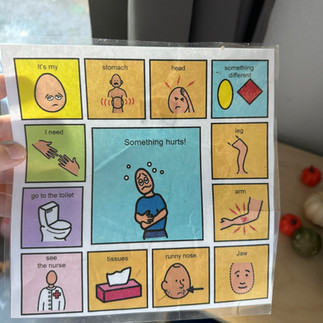Supporting Children with Disabilities in the Child Care Setting
- Danielle Letourneau
- Nov 22, 2024
- 3 min read

Make sure BASIC NEEDS are being met:
This is the NUMBER ONE thing to remember before trying to differentiate anything as far as instruction, equipment, etc. I have heard so many horror stories from parents in regards to their child being ignored or mistreated by caregivers. Honestly this was part of the reason I started this blog- to HELP Child Care Providers understand how to care for children with special needs.
You do not have to have training to understand that a child with a disability needs food, water, and a clean diaper just like every other child. Of course there may be restrictions on food but if you communicate with parents and ask them to send food with their child or buy safe foods for the daycare just in case, this shouldn't be an issue. There is no excuse to treat a child a different way when we ALL have the same basic needs.
Use VISUALS in an EFFECTIVE way:
I am sure that you have already been given the suggestion to use visuals. Believe me, as a former Special Education Teacher of 6 years, making visuals is one of the most effective ways to communicate and get children with disabilities to understand language in a functional way (it helps with neurotypical children as well). Now, at first, I was not completely sold on using visuals for every student because I did not believe they WORKED for every student.
I was WRONG.
Some students require a single visual reminder to complete a task or follow directions while others require a single action to be broken down into a visual list of steps. Below are examples of visuals I use in my toddler classroom but these could definitely work for any age:
TIP: When creating visuals for misbehavior, remember to create a visual for the action that you want REPLACING the behavior. For example, if you are trying to get a student to sit on a chair instead of climbing or standing, make a visual of a person sitting with the word "sit" or "sit in chair" INSTEAD of "no climbing" or "no standing".
INCLUDE students ALWAYS - PRESUME competence:
Just because a student has a disability does NOT mean that they need to be left out of curriculum or activities because they do not understand what is happening. Children with Autism, Down Syndrome, etc. just have a more difficult time expressing what they understand and need help with functional language (communicating in order to get needs and wants met).
ALWAYS PRESUME COMPETENCE
But what does this mean? Assume children with disabilities are able to understand everything you are saying and doing.
Many children with disabilities are excellent at masking (copying what their neurotypical peers do in order to fit in) and learn how to observe others in order to figure out what needs to be done.
For example, if you are doing Circle Time and it is time for students to pick the weather, do not just assume your student with Autism will not be able to participate. Have VISUALS printed with weather choices and start with ONE CHOICE. Point to the choice and say the word. If the student does not repeat that is okay- they can participate in their own way. One day, they may surprise you with what they know! Repetition is KEY.
Children with disabilities have a different way of viewing the world and interacting with others around them- make sure you are not always trying to "fix" the way they interact but try to UNDERSTAND through behavior and observation.
I feel like sometimes, people are unsure of what to do and how to approach children with disabilities that they forget to treat them the same as everyone else. THAT is the takeaway here: treat them as you would any other child.
I truly hope this helps and if you have any questions on how to further support children with disabilities, please never hesitate to contact me and ask.
Danielle

















Comments